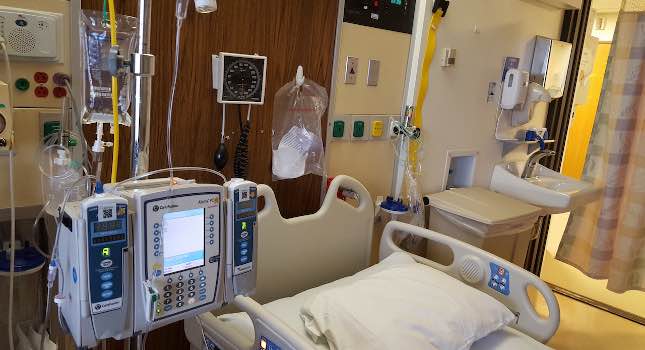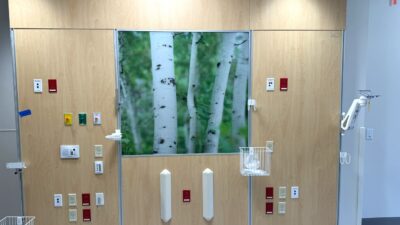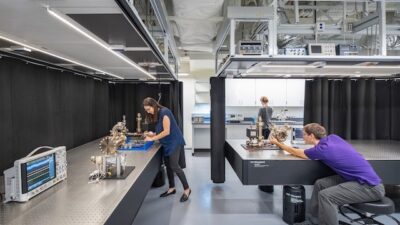The COVID-19 pandemic together is making hospitals reconsider technologies or methods that might have been shunned or minimized before the crisis.

Our nation’s hospitals already have incredible systems in place to battle infectious diseases and we predict many will be looking for new technologies to strengthen their resilience and safety in the face of future challenges. Some of these technologies were previously ruled out due to concerns related to cost, privacy, or adaptability, but we think these four ideas should be reconsidered in the post-COVID-19 world.
1. More built-in technology to quickly adapt swing spaces
Hospitals will likely be looking at more ways to improve flexibility within their patient rooms to convert them into “swing spaces” to adapt more quickly and safely in times of a surge. While this adaptation was a cost concern in the past, hospitals are reconsidering their surge capacity criteria now more than ever before.
A key element to these new flexibility standards will be ensuring the technologies found in more complex, intensive care areas are built into more rooms and suites that do not currently have that capacity. These technologies can include nurse call systems, physiological monitoring systems and more extensive coverage for telemetry systems. Other services will also need to be included, such as oxygen, medical air, medical vacuum and increased emergency electrical capacity.
Beyond converting specific rooms, hospitals might also consider preparing entire buildings to become swing spaces. For example, ambulatory care facilities can be designed with the needed technologies and infrastructure to provide emergency patient care when needed, and hospitals can include medical gas hookups and extra outlets within the walls of public areas like cafeterias for use in emergency, last resort situations.
2. An increase in handwashing monitoring systems
There are many automatic infection control systems in hospitals that aid in keeping the environment safe for patients and staff. However, handwashing monitoring systems have often been considered unnecessary if protocols are enforced. Healthcare-associated infections (HCAI) are a major cause of death and disability worldwide, according to the World Health Organization (WHO). Hand hygiene is the primary measure proven to preventing HCAI’s and the spread of antimicrobial resistance. Insufficient or very low compliance rates have been reported from both developed and developing countries with an overall average of 38.7% who comply, says the WHO.
There are different levels of handwashing technology currently available, from those that monitor usage to fully automated systems that track healthcare workers’ movements and product dispensation events. Many systems provide real-time feedback such as an audio alarm when a staff member approaches a patient without verification of washing their hands. This reminds workers to perform the essential hygiene steps enforcing the necessary safety precautions.
3. An unprecedented move to telehealth
Many hospitals that hesitated to move to a broader telehealth model were forced to undergo that transition during the crisis, ready or not. Many questions that might have previously delayed the wider implementation of telehealth remain true to this day like privacy, cybersecurity and patient/staff onboarding. However, many hospitals moved quickly to telehealth in order to carry out necessary appointments and services online, despite all of the outstanding concerns.
It is still vitally important to address these concerns, but hospitals are already becoming more willing to better understand the risks involved while moving toward broader implementation to improve the way they deliver care when face-to-face appointments just can’t happen. As telehealth becomes more widely adopted, there will be a great need to educate both the hospital staff and also the patients about how to use the tool most effectively. Additionally, hospitals will need to assess if their patients have the technology necessary to access the care they need.
Telehealth can accommodate many aspects of care for patients in the home or prior to admission at a hospital. It presents an opportunity for pre-screening via phone or video calls with emergency room physicians or on-call staff if resources at the hospital are limited. Our current crisis has also created support for utilizing smartphone apps with integrated digital devices to monitor vitals remotely for at-risk individuals. Being able to monitor an elderly patient or a person with underlying conditions without bringing them into contact with other people is a great benefit that we predict hospitals will begin to realize on a massive scale.
4. RFID asset tracking software
During this outbreak, many healthcare facilities faced the biggest surge in patients needing specialty equipment and staff needing more personal protective equipment than ever. When under pressure, time cannot be wasted on searching for medical equipment. One of the key components to better workflow is asset tracking and management — and hospitals will certainly be looking at this in the future.
A radio frequency identification (RFID) system, when implemented properly, allows staff to know the exact location and condition of critical resources they need. Many systems are able to track products not only by room or bay, but even by shelf-level locators. Expanding on this technology and tracking staff and patients can be a crucial aspect of defending the spread of infectious diseases in hospitals. The ability to know who and what the staff came in contact with can reduce the risk prior to it getting out of control.
Integrating RFID technology by using existing wireless network systems usually isn’t difficult, but the change in culture and past practices is often what held hospitals back from implementing this in the past. Assuring the staff that the tool won’t be used to limit the way they practice medicine is key. Like many of the technologies discussed, we predict a great need for education and familiarization of this technology in order for it to perform as intended.




